Financial Markets in Turmoil – Why the Gold Price has Dramatically Risen
23/11/2020Daniel Fisher
Free & fully insured UK Delivery. Learn more
Secure & flexible payments. Learn more

Buyback Guarantee Learn more
Having stood the test of time over the years, the yellow metal has turned into an asset class that investors frequently depend on during times of economic turmoil. Gold has historically been seen as a safe haven and an investment vehicle that generates steady returns.
While the appetite for gold has risen and fallen over the years, it is obvious that gold demand skyrockets during times of crisis. The world has seen much of this in the last couple of decades. The demand for gold feeds on the fear of investors and looking back to 2011, we can see that the spot price of gold reached its highest point in August of that year. The all-time high, which crossed $1900, was at the height of the global economic crisis at the time.
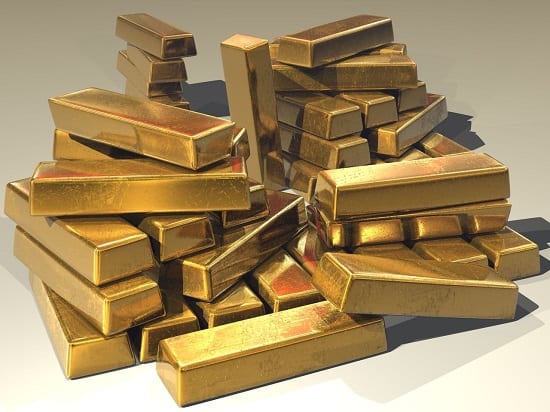
Physical gold investments have gone through the roof during COVID-19
Most researchers study the anatomy of an economic crisis by measuring the financial impact, supply and demand issues and political ramifications. However, one of the largest problems that follow a global crisis is social impact. Epidemic diseases create the fear of death, which in turn breaks down society. Standard economic measures taken by governments can only soften the blow to an extent. In reality, there would still be people who cannot pay their bills, housing foreclosures and a growing banking crisis.
Currently, we are in the middle of what could be the largest global pandemic the world has ever seen. At the time of writing this article, the US has approximately 6.1 million confirmed cases of COVID-19, with 186,000 deaths. Likewise, the UK has over 335,000 cases and more than 41,000 deaths. The numbers are staggering and continue to grow every day. Unemployment in the United States reached an all-time high of 14.70% in April 2020. Needless to say, these economic pressures have penetrated deep into the heart of American society, destroying any semblance of economic stability that was previously there.
One of the key barometers of Britain’s economy is its housing market. These figures show a drop in demand of around 40% at the end of March 2020, according to Zoopla, a well-known property-related website. The drop in demand isn’t linked to the availability of housing. Importantly, it is the outcome of a shrinking economy, where the lack of job security has resulted in an exodus of buyers. Many businesses have become bankrupt during the lockdown and this has also had a huge impact on commercial properties. Moreover, the post-pandemic era is likely to see a greater number of people moving to homeworking. Prime commercial property, for example in Central London, will lose its lustre due to reduced demand.

Prime real estate in London currently has few takers
Other areas of the economy have also taken a significant hit. A report by the Financial Times indicated that automobile sales were down by 97% in May 2020 – the biggest drop in three decades. The United Nations has published a report that estimates the damage to the global economy to be US$1 trillion. In fact, the UN has requested countries all over the world to spend now, in order to avoid a long period of economic uncertainty. The economic think tank of the UN has advised that a lot more needs to be done, rather than reducing interest rates and cutting taxes. In March 2020, the US government released a stimulus package designed to help businesses across the country. The package included payroll tax cuts and certain emergency measures to reduce job losses across businesses.
The UK government was pro-active in the creation of an employee welfare scheme called the ‘furlough scheme’. This scheme was designed to help UK employers retain employees during crisis periods when employees could lose their jobs, the company ‘furloughs’ the worker, i.e. puts them on the scheme. The government pays 80% of the wages, up to £2,500 a month, while he/she is laid off. Two out of three British employers have used the scheme in the past. However, this scheme is likely to be pulled to reduce government spending. Many UK workers are likely to face tough times once the scheme is shut down.
Closer to home, the German economy entered into a recessionary phase due to the impact of COVID-19. Germany had gone into recession in 2009, during the last global financial crisis. This time around, the country’s economy shrank by 2.2%, pushing the nation into recession.
Along with Germany, the Eurozone has also been plagued with problems of its own. Countries like Italy are reeling with high debt and zero or negative growth. During the previous financial crisis, nations like Italy, Greece and Portugal were bailed out by countries like Germany and the UK. This time around, things are looking grim. Brexit has already brought the continent under pressure throughout 2019. Now, the future of the Eurozone lies in the balance and radical economic action and fiscal measures are required by Brussels to ensure the inclusion of countries like Italy.
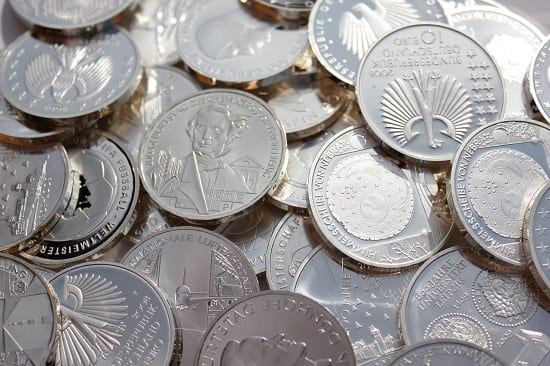
The demand for investment silver has risen since COVID-19
Other assets have also been impacted. De Beers, one of the world’s largest manufacturers of diamonds reported a 28% decline in sales. Leading companies have also been forced to close down their sales channels, including exhibitions. Some companies have begun exploring the option of selling online however sales volumes are yet to rise.
The price of silver had fallen to a low of $12.01 on 19th March 2020, but as the COVID-19 crisis hit the price has surged to a current $27.53. This represents a stunning 129% price rise in just five months. This topic is discussed in detail later but is largely due to silver similarly to gold being classified as a safe haven investment.
There is an intangible impact of the pandemic, which many people don’t realise. Yet, this impact is disastrous for financial markets. It is often said that the money runs away from where it is scared. Fuelled by speculations on social media and the media, the virus of fear has spread throughout the global economy. In countries where a strict lockdown was designed to stop the virus from spreading, an economic disaster ensued, killing off businesses and depleting jobs. On the other hand, the countries that followed a lighter approach ended up having unbridled transmission of the virus, resulting in the loss of human lives. This is the paradox that the world is dealing with. It is an unprecedented situation, to which there appears to be no immediate solution.
The global stock markets have responded similarly, with the FTSE downward slide started from March 2020. Similar crashes were recorded in the S&P index and the Dow Jones. As the markets turned bearish, investors pulled out their investments. The domino effect of the coronavirus is likely to beleaguer the economy long after the threat of the virus has passed. This is a crisis with a magnitude of epic proportions that no one could predict.
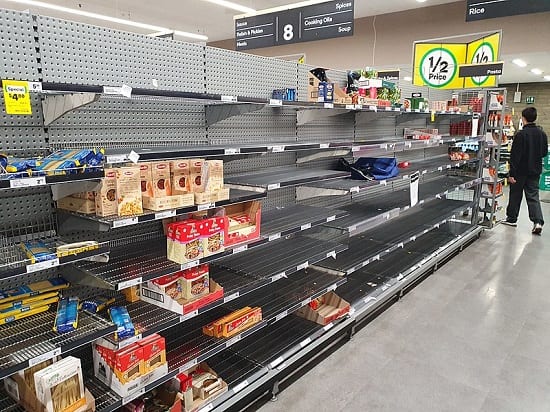
Panic buying resulted in depletion of supplies from supermarket shelves
Another significant impact of COVID-19 has been the turmoil witnessed in consumer markets across the world. As the crisis unfolded, people rushed out to stock food, toiletries, essential items, sanitizers and other disposables. Nielsen, the market research company reported that sales of pasta increased by 168% during the pandemic, while canned pasta and canned meat were up by 148% and 147%, respectively. This kind of consumer behaviour creates a void in the economy, creating supply and demand issues.
When there is an unprecedented spike in the demand for food and other commodities, systems often struggle to respond, and shortages are created. In many developing countries, the COVID-19 crisis has resulted in speculative prices of commodities being charged by unscrupulous traders. In a situation where unemployment is on the rise and families are cash-strapped, this creates a vicious cycle that can severely impact underprivileged members of society.
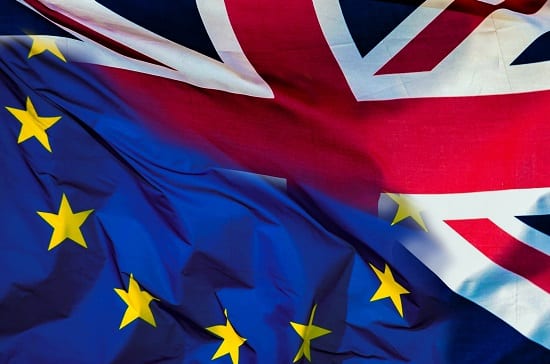
2019 was the year of Brexit
At the same time last year, no one had anticipated that the pandemic would be upon us soon. 2019 was the year of Brexit. Post the general election in the UK during the previous year, Prime Minister Boris Johnson moved forward to sign the Brexit deal with the European Union. As the threat of a no-deal Brexit loomed over the country for a long time, the price of Sterling had weakened. Naturally, the gold prices went up, as investors lost confidence in the British pound. The uncertainty that the UK might leave the EU without a deal in hand, further impacted the value of the Sterling. The price of gold had shot up shortly after the Brexit vote in June 2016.
Download The 7 Crucial Considerations when buying gold & silver FREE. Click HERE
The former Governor of the Bank of England, Mervyn King said,
“The world economy is sleepwalking into a new financial crisis”.
Lord King was in charge of the Bank of England in Threadneedle Street during the 2008 financial crisis. He warned that a stagnating world economy was poised at the brink of yet another major financial crisis. A low growth trap, compounded by the uncertainty around Brexit, the US-China trade wars, political tensions within Europe regarding the direction of the Euro and socio-political issues in the emerging economies were all key factors for pushing the world towards another debacle.
Ironically, in hindsight, we realise that the world economy was already fraught with numerous problems. No one knew that COVID-19 would soon arrive. By August 7, 2019, the price of gold breached the $1,500 mark. It hovered at these levels through the next few months, reaching a price of $1,527 on 2nd January 2020. It reached a new high of $2,067 on 6th August 2020.

The Great Depression of the 1920s – Australian schoolchildren queue up for free soup
Businesses in the UK were already struggling, amidst plummeting sales driven by a drop in consumer demand. For example, high-street retailer Laura Ashley was struggling by February 2020, to save the business. The company reported an 11% drop in sales through the latter half of 2019. The company’s share price went down by 38% when the media reported the news. By this time, borrowing restrictions were already in place by the major banks and struggling high-street businesses were finding it hard to stay above water.
A well-known parameter used to check the health of the world economy is the oil price. During the 2008 recession, global oil prices had dropped to $33.87 a barrel in December 2008. The 2020 oil crisis, also known as the coronavirus oil crash, had very little to do with the virus. The breakdown of talks between Russia and Saudi Arabia triggered a price war in March 2020, when the OPEC failed to stabilise the market. Saudi Arabia went on to dump crude oil into the market at heavy discounts. As a result, WTI crude plunged by 24.59% to trade at $31.13 per barrel. This was a historic low since the Middle Eastern war in 1991. Goldman Sachs, the global investment bank cut back its 2nd and 3rd quarter Brent forecast for the year to $30 a barrel, indicating that prices could eventually fall as low as $20. Read our detailed article about the relationship between gold and oil prices.
Sergio Ermotti, who heads the Union Bank of Switzerland (UBS), has been quoted as saying that he has never witnessed the magnitude of what he is seeing now. Banks have been saddled with a problem of epic proportions, which include weak profits, little or no dividends or bonuses. Sadly, this comes at a time when investors are already tight-fisted. After the sub-prime housing market crisis of 2008, most banks across the world took steps to protect themselves against another similar meltdown. However, the COVID-19 crisis has caught everyone off-guard. A combined sum of US$139 billion has been set aside for loan loss provisions. However, the financial experts at Accenture have predicted that the actual cost of bad debts could rise to US$880 billion by 2022.
Back home, things aren’t great either. In June 2020, Forbes magazine published a scathing article titled “The UK economy is broken”. In that article, the Bank of England chief is reported to have said that the current financial crisis is the worst in 300 years. That takes us back to an era that predates the industrial revolution. The implications of that statement are huge. It would imply that as the current crisis unfolds, it will reach a dimension never seen by anyone in their living memory.
Government debt level has crossed 101% and is headed upwards. On the other hand, the tax coffers are emptying, as overall tax collections have reduced by 28% or more. This includes VAT, down by 46% and income tax, down by 29%. In the scheme of things, the government would find it very hard to bail out the UK banks in the event of a collapse, like it had done in the case of Northern Rock and RBS, back in 2008.
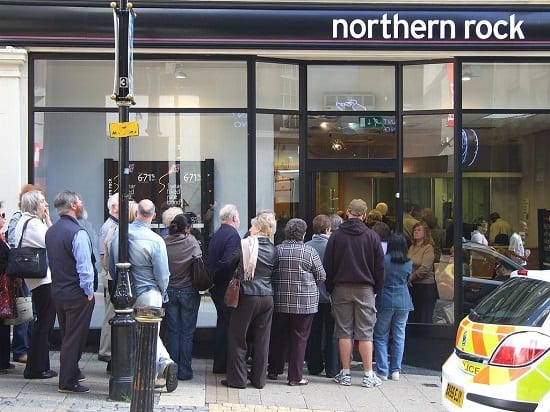
Investors queue up to recover their savings from Northern Rock in 2008
The COVID-19 stock market crash started on 20th February 2020. By March, the global stock markets had fallen by approximately 25%. Of course, this was a case of investors turning bearish as the pandemic started spreading and the news hit the stands. It’s interesting to note that barely a few days before, on 12 February the global stock markets were at an all-time high. This included the S&P, NASDAQ and the Dow Jones. It goes to show how fragile and volatile equity markets can be. In reality, when the market free-falls, there is no safety net.
By May, there was a recovery rally and the US indices hit new highs on 17th August 2020. Interestingly, this bull-run on Wall Street was led by technology companies who operate in areas like cloud computing and machine learning. The lockdown had proved to everyone around the world that education, business and many other services were moving online in the post-pandemic phase.
Virtual events were being hosted all over the world, while consumers have moved to ‘no contact’ online shopping. Videoconferencing players like Zoom are suddenly seeing a huge surge in their businesses, as all business meetings and conferences are being conducted through remote facilities. Investors were, therefore, keen to invest early in these companies, along with the likes of the big players like Amazon, Microsoft and Apple.
It’s important to note that the current correction and buoyancy in the stock market is not reflective of the global economy at large. Stock markets have historically risen on investor sentiment. At the moment, it appears that investors have turned to the market in the hope of making quick gains, despite the fear of coronavirus. The nature of such volatility usually creates a bubble that the general public should be wary of.

Restaurants like Nandos have suffered huge losses during COVID-19
In reality, a closer look at the high-street tells us that every sector in business is suffering. Airlines have suffered huge losses, along with the tourism and hospitality industry. The popular European airline Flybe, which had been rescued from the brink of a financial collapse last year, has gone into administration. The weakening Sterling has impacted all UK airlines, with an increase in the cost of aviation fuel and aircraft leasing. However, this added to the woes of Flybe, which had a 40% exposure to the regional UK air travel market. Once the domestic market shut down due to COVID-19, it was practically the last nail in the coffin for the airline.
In the hospitality segment, restaurants and tourism were hit hardest by reduced consumer spending and travel prohibitions. 27% of UK residents delayed their vacation plans due to the outbreak of the virus, while a further 11% were forced to cancel their existing holidays. This has had a huge impact on the entire tourism sector in the UK. The country regularly enjoys a surge of tourism during the summer months from overseas residents, which has come to a grinding halt this year.
Tourism in England alone brings £106 billion annually, supporting 2.6 million jobs in the UK. Market pundits now predict that the tourism sector in the UK is likely to shrink by 59%, leading up to 2021. It’s important to bear in mind that these figures merely represent the leisure segment. Commercial and business travel, which is a huge contributor to the UK economy has vanished completely.
Likewise, the sports and sports event sectors have also taken a hit. The revenue in these sectors come from multiple streams. Firstly, fans and audiences contribute to revenues by attending events. Then, there are revenues associated with travel and tourism-related to sports. The collection of viewership revenues from television channels is yet another big contributor. Lastly, the sector generates employment for individuals tasked with security, maintenance, ticket collection, and several other services. Sports education is also a major contributor.
In an unprecedented turn of events, the Olympics and Paralympics scheduled to be held in Tokyo, Japan were postponed till 2021. The world had geared up for this great sports extravaganza, but now all the revenues and jobs surrounding the events have been shelved temporarily. While the games are scheduled to be held in 2021, it remains to be seen how the coronavirus battle will be played out. If the pandemic is still around in 2021, the games may be further rescheduled or cancelled altogether.

The Tokyo Olympics has been postponed to 2021
The coronavirus could not have picked a worse time to enter the world. The US-China trade war had just started easing out when the coronavirus pandemic took hold. Possibly one of the biggest fallouts has been the exposure of dependencies on China that global businesses have today. The US, Japan and France have started advising their companies to limit their reliance on Chinese manufacturing within their supply chains. In fact, when the pandemic started in China, the first thing that happened was a breakdown of the international supply chains linked to Chinese manufacture. In a globalised economy, the effects of the coronavirus disruption were felt instantly as the supply of goods simply vanished.
The pharmaceutical industry is trying to limit their reliance on Chinese drug manufacturers by initiating efforts to build a raw material supply chain within the United States and Europe. Sanofi SA, a leading French pharmaceutical company is putting an API supplier in place to reduce its dependency on China. The company management says that this development will be an important one for the pharmaceutical giant, as it will become the second-largest global producer, notching up annual sales figures of €1 billion by 2022.
In 2019, Chinese manufacturing companies had secured US$223.7 billion worth of business. Automobile parts, computer peripherals, and even plastic goods arrive in the West from China. Apart from being a base for low-cost manufacturing, China is also a lucrative market. The country has more than 1.3 billion consumers, many of whom are upwardly mobile and display healthy spending patterns. This provides much-needed relief for international companies, whose markets in the West have significantly declined due to lack of consumer liquidity.
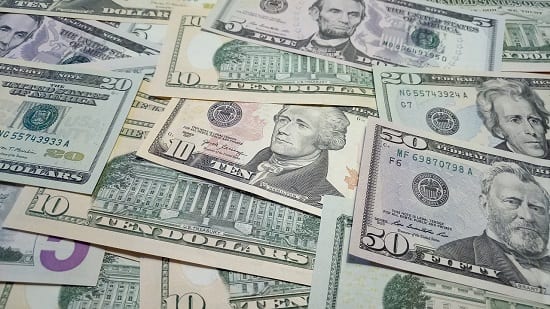
The US Dollar is emerging as a strong global currency due to the pandemic
The long arm of COVID-19 has reached well beyond the global banking sector, stock markets and business sectors in countries. It’s no surprise that the global currency markets have felt a significant impact. The weakening global economy, backed by the rise of unemployment in the US and Europe has led to investors moving to the US dollar as a solid, safe currency.
Although many believe that this could be a silver lining for the US, in reality, these movements do not reflect a long-term commitment to the US economy. Government debt is at an all-time high, along with rising unemployment. The fundamentals of the US economy could be undermined by these long-term factors, and the current price of the dollar could be driven by short-term investor sentiment. A lot depends on the US elections scheduled for November 2020. Additionally, the rise of the US dollar will create inflation for other currencies around the world, impacting imports of goods and services.
The British pound, however, has declined to its lowest level in 30 years. Market experts believe that the weakness of the pound could be dependent on speculations regarding the UK government’s plans to fund emergency economic measures to weather the storm of the coronavirus pandemic in the country. The package of fiscal measures announced by the British government simply means more borrowing for the UK. Economic experts are worried that the UK may be steering headlong into a debt crisis with no immediate solution in sight.

Gold has performed extremely well during the pandemic
It is now abundantly clear from the points discussed above, that the COVID-19 pandemic has hit deep into the heart of the global economy. Gold, however, has beaten the pandemic blues and continues to climb to record levels. This is largely because gold is considered to be a safe haven for investors. During the height of the 2008 economic crisis, gold reached an all-time high, crossing the $1900 barrier. That record has now been broken and the spot price of gold crossed $2000 in August this year. Falling interest rates, lack of confidence in the world economy and the uncertainty in the currency markets have all contributed to the rise of gold. With the gold demand in focus, an unprecedented level of 734t of gold has flowed into gold-backed ETFs.
The journey to this unprecedented price point had already started in 2019. Although the world was unaware that the coronavirus pandemic would soon be coming, wary investors had already started moving to gold to strengthen their investment portfolios. There were talks of yet another global recession on its way. If we look at gold price charts from September 2017, we can see that the spot price of gold never crossed the $1,500 price point up to August, last year. On 7th August 2019, the price of gold reached $1,506 for the first time in three years, almost a year ago. In April, earlier this year, the gold price hit the $1,700 mark, subsequently reaching its highest point of $,2067 on 6th August 2020.
Supplies of gold remained strong and resilient throughout this period. In the first quarter of 2020, many refineries were shut, along with mining company operations. The travel restrictions also disrupted the supply chain. These disruptions caused market premiums to rise on the back of high demand.
The table below covers the percentage growth rates of gold from 2005 to 2011 during the bull-run. In the adjoining column, the Bank of England interest rates during these years are shown. In 2009, the UK embarked on its first quantitative easing programme, dropping interest rates to a historic 0.50% and releasing £75 billion into the economy through quantitative raising. There were no other quantitative easing programmes launched during 2005- 2011. The next one was during the Eurozone debt crisis, releasing £375 billion of relief into the UK economy. The Brexit QE program released £445 billion in 2016 and the 2020 coronavirus pandemic QE program released £745 billion.
| Years | Percentage Rise for Gold | Bank of England Base Rate | Quantitative Easing (QE) |
| 2005 | 31.06% | 4.50 | |
| 2006 | 8.95% | Aug 06 – 4.75 Nov 06 – 5.00 | |
| 2007 | 28.88% | Jan 07 – 5.25 May 07 – 5.50
Jul 07 – 5.75 Dec 07 – 5.50
|
|
| 2008 | 42.75% | Feb 08 – 5.25
Apr 08 – 5.00 Oct 08 – 4.50 Nov 08 – 3.00 Dec 08 – 2.00 |
|
| 2009 | 14.77% | Jan 09 – 1.50
Feb 09 – 1.00 Mar 09 – 0.50 |
UK’s first QE program reduces the base rate to 0.50 and QE of £75 billion announced to aid the economy. |
| 2010 | 32.82% | 0.50 throughout | |
| 2011 | 12.28% | 0.50 throughout |
When building a portfolio, gold is a great choice for investors since it creates insurance and balance for the portfolio. It insures against times like these when the global economy and capital markets go into a tailspin. Gold is essentially a mechanism for hedging the risks associated with other vehicles of investment. An important attribute of gold is that it is not subject to counterparty risks. These are risks that are inherent in any form of paper-based investments, such as stocks, mutual funds, bonds, etc.
Silver was at a 10-year low price of $12.01 per oz on 19th March, which was around the time that COVID-19 really started to take a grip in Europe and the US. Following this, silver prices added 25% between April to June 2020, with May alone rising from $14.94 to $18.28. The main factors causing this were:
There are too many factors to list all of them, but the above will give an idea. The silver price increase was in spite of a drop in industrial demand due to COVID-19 disruptions to industrial output (e.g. photovoltaic cells in solar panels).
The gold to silver ratio currently is 71.2, which suggests that silver remains an excellent investment as for much of history this has traded at only 15 oz of silver for 1 oz of gold.

Call Physical Gold to buy gold bar bundles of 3,5 and 10
To respond to the increased demand for gold, we have added some excellent bundled deals that can protect your wealth and strengthen your portfolio. We now have a bundle of 10 bars, with each bar weighing 10g. Similarly, there are 3 bar and 5 bar bundles weighing 50g and 100g, respectively.
The gold price is clearly at an all-time high, no matter which currency you want to buy gold in. In GBP terms, the price of gold has shot up by more than 35.6% in 2020 alone. Many investors are adopting a ‘wait and watch’ policy. We often receive feedback from these investors that they feel they’ve missed the price point and now need to wait for the prices to go down, for them to invest. This couldn’t be farther from reality. Gold prices rise steadily, and a gold bull-run does not necessarily end at the end of the year.
Many people think that the COVID-19 pandemic will simply end, as suddenly as it appeared, and the economy will revert to normalcy by 2021. At Physical Gold, we believe that this is likely to be a sustained run and buying gold can protect your wealth even now if you haven’t bought already. The last gold bull-run took place from 2005 to 2011. During that time, we had countless discussions with buyers about what they should do. If you’re thinking of buying gold during the current pandemic, please speak to Daniel Fisher, by calling (020) 7060 9992 or contact us online and we’ll get back to you.
Image Credits: Pixabay, Wikimedia Commons, feiern1, Wikimedia Commons, Public Domain Pictures, Wikimedia Commons, Wikimedia Commons, Wikimedia Commons, Wikimedia Commons, Christoph Meinersmann/54, Jeremy Schultz and Wikimedia Commons
Live Gold Spot Price in Sterling. Gold is one of the densest of all metals. It is a good conductor of heat and electricity. It is also soft and the most malleable and ductile of the elements; an ounce (31.1 grams; gold is weighed in troy ounces) can be beaten out to 187 square feet (about 17 square metres) in extremely thin sheets called gold leaf.
Live Silver Spot Price in Sterling. Silver (Ag), chemical element, a white lustrous metal valued for its decorative beauty and electrical conductivity. Silver is located in Group 11 (Ib) and Period 5 of the periodic table, between copper (Period 4) and gold (Period 6), and its physical and chemical properties are intermediate between those two metals.